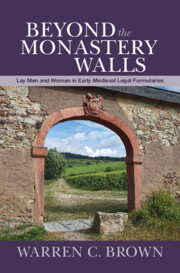Book contents
- Beyond the Monastery Walls
- Beyond the Monastery Walls
- Copyright page
- Dedication
- Contents
- Figures
- Acknowledgments
- Abbreviations
- Part I The Gate
- Part II The Laity
- 4 Laypeople and Documents
- 5 Laypeople and Property
- 6 Family
- 7 Conflict and Justice
- 8 Power, Personal Relationships, and Letters
- 9 Freedom and Unfreedom
- 10 Conclusions
- Bibliography
- Manuscript Index
- Main Index
9 - Freedom and Unfreedom
from Part II - The Laity
Published online by Cambridge University Press: 09 December 2022
- Beyond the Monastery Walls
- Beyond the Monastery Walls
- Copyright page
- Dedication
- Contents
- Figures
- Acknowledgments
- Abbreviations
- Part I The Gate
- Part II The Laity
- 4 Laypeople and Documents
- 5 Laypeople and Property
- 6 Family
- 7 Conflict and Justice
- 8 Power, Personal Relationships, and Letters
- 9 Freedom and Unfreedom
- 10 Conclusions
- Bibliography
- Manuscript Index
- Main Index
Summary
The formulas describe unfree men and women with terms that are fluid and overlapping, and that encompass everything from what we would call chattel slavery to loose patronage. The unfree most often appear as the passive objects of the power and interests of their betters. They are not a closed group, however. Free people submitted themselves to servitude either voluntarily or by force of circumstance, in exchange for money or to make amends for some wrong. Unfree were freed or bought their own freedom. The unfree also display a significant amount of agency. They ran away. They sought help against their own lords from other powerful people. Sometimes they stole things, including marriage partners. They contested their status, often with success. Some even owned other unfree. In short, the formulas tell us that status at the interface between free and unfree was fluid, and that while they spent much of their lives as the passive objects of power, the unfree in this world had the capacity to act in their own interests, were fully aware of how power flowed, and could work the social and political system to their own advantage.
- Type
- Chapter
- Information
- Beyond the Monastery WallsLay Men and Women in Early Medieval Legal Formularies, pp. 284 - 320Publisher: Cambridge University PressPrint publication year: 2022

